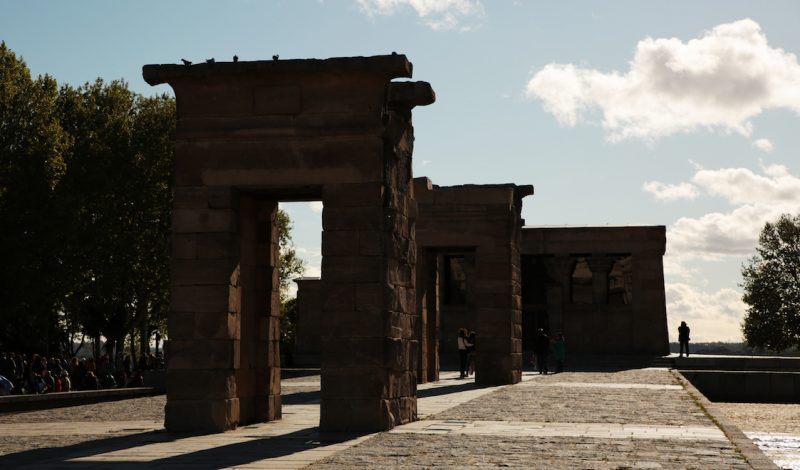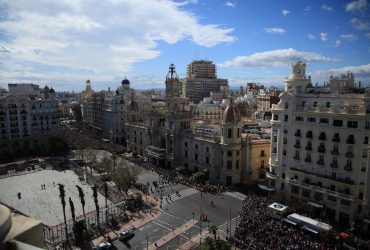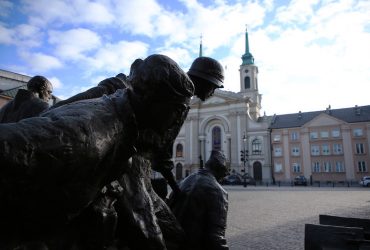Today, with this post, I take you for a walk in Madrid, to discover some of its most (or less) famous places and monuments. I’ll take you to explore practically the whole city starting from the southeast, near the parquet of the Buen Retiro, to move towards the north-west and we end in the north-east at the Puerta de Europa. But let’s start for this walk of about half a day (with a good pace and proper use of public transport in Madrid).
Puerta de Alcalá
This door-arch of triumph is one of the most significant monuments of Madrid. Located in the centre of Plaza de la Independencia, near the Parque del Retiro, it was built by order of Charles III to replace
 the 16th-century door. At the time it was one of the five ancient royal gates that allowed access to Madrid. Designed by Francesco Sabatini in neoclassical style, it is built in granite and was inaugurated in 1778.
the 16th-century door. At the time it was one of the five ancient royal gates that allowed access to Madrid. Designed by Francesco Sabatini in neoclassical style, it is built in granite and was inaugurated in 1778.
The difference with the Puerta de Toledo and the Puerta de San Vicente lies in the five arches (arches) instead of the “usual” three that usually characterized this type of door. The two facades have different decorations: on the inner side, which initially was the one facing the city, the decoration is, and there are depicted the four virtues (Prudence, Justice, Temperance and Fortress); on the outer side, visible when entering Madrid, is the royal coat of arms. It owes its name to the fact that it is located next to the road that led to Alcalá de Henares. Today it is obviously immersed in traffic, it no longer represents the entrance to the city, but it is striking for its majesty.
Tropical garden of the Atocha station
The Atocha station, inaugurated in 1851 with the name “Estación del Mediodía” (Mid-day station), is the oldest and most important station in Madrid.
 The building underwent two renovations: in 1888, after a severe fire, and between 1985 and 1992 when its dimensions were practically quadrupled! Today the station is divided into three zones: Madrid-Puerta de Atocha, Madrid-Atocha Cercanías and Atocha Renfe (the metro station). The building of the old Atocha station, when it was reopened as a station for high-speed trains (AVE), was turned into a tropical garden for decorative purposes. The garden is composed of thousands of plants, of 260 different species from America, Asia and Australia. The transformation work of the ancient building was “easier” also thanks to the old roof created at the end of the nineteenth century by Alberto de Palacio Elissagne, with the collaboration of Gustave Eiffel. The garden is accessible free of charge and around it there are also benches, stalls, bars and small shops: the station has been transformed into a place populated by many people who come here (if they don’t have to take a train) to spend some time in tranquillity in a green oasis full of city chaos.
The building underwent two renovations: in 1888, after a severe fire, and between 1985 and 1992 when its dimensions were practically quadrupled! Today the station is divided into three zones: Madrid-Puerta de Atocha, Madrid-Atocha Cercanías and Atocha Renfe (the metro station). The building of the old Atocha station, when it was reopened as a station for high-speed trains (AVE), was turned into a tropical garden for decorative purposes. The garden is composed of thousands of plants, of 260 different species from America, Asia and Australia. The transformation work of the ancient building was “easier” also thanks to the old roof created at the end of the nineteenth century by Alberto de Palacio Elissagne, with the collaboration of Gustave Eiffel. The garden is accessible free of charge and around it there are also benches, stalls, bars and small shops: the station has been transformed into a place populated by many people who come here (if they don’t have to take a train) to spend some time in tranquillity in a green oasis full of city chaos.
The 11M attacks
The Atocha station was one of the places hit by the 11 March 2004 attack, one of the most significant attacks to date in Spain. In the explosion 191 people died, travelling on four trains. On 11 March 2007, a monument dedicated to the victims of the attack was inaugurated outside the station.
Metròpolis building
At the beginning of the 20th century Madrid became a city open to the world and wanted to follow up on its desire for modernity:
 From this came the great construction activity of buildings and new infrastructures. The Metropolis Metròpolis building, on the corner of Via Alcalà and Gran Via, is one of these symbols. It was designed by the French architects Jules and Raymond Février, it began as an insurance building and to build it was necessary to demolish seven houses. It was completed by the French architect Luis Esteve-Fernandez Caballero in 1910. The inauguration took place on 21 January 1911, when the Gran Via was a construction site and the first building built was the Grassy building. Very particular is its black slate dome, with gilded decorations woven and finished by a splendid winged victory. On the second floor, there are pairs of Corinthian columns that support a third floor decorated with statues representing commerce, agriculture, mines and industry.
From this came the great construction activity of buildings and new infrastructures. The Metropolis Metròpolis building, on the corner of Via Alcalà and Gran Via, is one of these symbols. It was designed by the French architects Jules and Raymond Février, it began as an insurance building and to build it was necessary to demolish seven houses. It was completed by the French architect Luis Esteve-Fernandez Caballero in 1910. The inauguration took place on 21 January 1911, when the Gran Via was a construction site and the first building built was the Grassy building. Very particular is its black slate dome, with gilded decorations woven and finished by a splendid winged victory. On the second floor, there are pairs of Corinthian columns that support a third floor decorated with statues representing commerce, agriculture, mines and industry.
Initially, at the top, there was a statue of the Phoenix that was removed by the former owners after having sold it. Currently, at the top of the building, there is a copy, and the real one can be seen at the Mutua Madrilena building in the Passo de la Castellana. Today the building belongs to the insurance company Metrópolis Seguros.
Palacio de Cibeles
The Palacio de Cibeles, now the Town Hall, was inaugurated in 1919 and declared a World Heritage Site with the status of Monument in 1993. The palace, designed by Antonio Palacios and Joaquín Otamendi, was built at the beginning of the 20th century as a venue for Correos (national postal service of Spain). It stands out as one of the first examples of Spanish modernist architecture.
Fuente de Cibeles
The fountain of Cybele (in Spanish Fuente de Cibeles) is located along the Paseo del Prado, where it was placed in 1782. The basin is characterized by a statue of the goddess Cybele (Cibeles in Spanish), the symbol of the earth, agriculture and fertility, on a chariot drawn by lions.
Around the fountain are the Palacio de Buenavista (Army headquarters), Palacio de Linares (Casa de América), Palacio de Comunicaciones (formerly the Post Office and currently the Madrid city hall) and the Banco de España. The fountain is the work of Francisco Gutiérrez (goddess and chariot), Roberto Michel (the lions) and the decorator Miguel Ximénez, in agreement with the Ventura Rodríguez project.
Puerta del Sol
Puerta del Sol is one of the most famous squares in Madrid. This square represents the “km 0”, the point from which the distances of the Spanish road network are calculated.
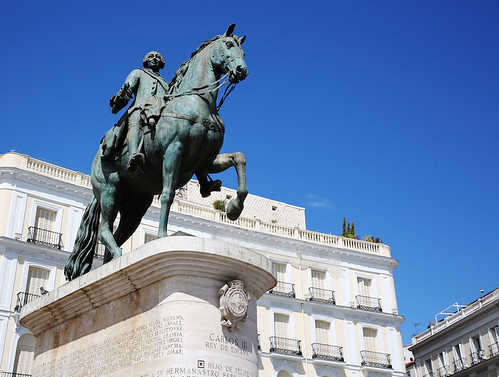 This square is the centre of New Year’s midnight national celebrations, with the famous clock striking the 12 strokes. Among the oldest places in Madrid, Puerta del Sol was built in the 15th century when the country’s capital was moved from Toledo to Madrid. In the beginning, government buildings overlooked the square, erected around the famous door that existed since the 12th century: this made it the focal point of Madrid city life. This square established itself over time as the preferred meeting place of the people of Madrid and in the eighteenth century impressive, but elegant buildings were built around it: among them, the Palazzo Delle Poste and the noble palace on which it was mounted the giant luminous sign by Tio Pepe. The latter is a commercial icon, used to advertise
This square is the centre of New Year’s midnight national celebrations, with the famous clock striking the 12 strokes. Among the oldest places in Madrid, Puerta del Sol was built in the 15th century when the country’s capital was moved from Toledo to Madrid. In the beginning, government buildings overlooked the square, erected around the famous door that existed since the 12th century: this made it the focal point of Madrid city life. This square established itself over time as the preferred meeting place of the people of Madrid and in the eighteenth century impressive, but elegant buildings were built around it: among them, the Palazzo Delle Poste and the noble palace on which it was mounted the giant luminous sign by Tio Pepe. The latter is a commercial icon, used to advertise
 a quality of sherry; it was restored in 2011 to be visible three years later. The statue of the bear and the arbutus tree is also very famous, built in the second half of the 20th century and today a symbol of Madrid. The animal, in the XIII century, was widespread in the woods around the city and rests on the madroño, that is the arbutus tree: the berries of this tree were used to cure the malarial fevers that struck the city in the sixteenth century. The same emperor Charles V used it (for this we find the five-pointed crown on the coat of arms). The statue is the work of the sculptor Antonio Navarro Santafé (1906-1983), it was inaugurated in 1967, and today the bear and the strawberry tree are reproduced in the flag of the city of Madrid and in the logo of the Atletico Madrid.
a quality of sherry; it was restored in 2011 to be visible three years later. The statue of the bear and the arbutus tree is also very famous, built in the second half of the 20th century and today a symbol of Madrid. The animal, in the XIII century, was widespread in the woods around the city and rests on the madroño, that is the arbutus tree: the berries of this tree were used to cure the malarial fevers that struck the city in the sixteenth century. The same emperor Charles V used it (for this we find the five-pointed crown on the coat of arms). The statue is the work of the sculptor Antonio Navarro Santafé (1906-1983), it was inaugurated in 1967, and today the bear and the strawberry tree are reproduced in the flag of the city of Madrid and in the logo of the Atletico Madrid.
The statue has always remained inside the square: it was located in the eastern part, between Calle de Alcalá and Carrera de San Jerónimo, until it was moved to the northern side in 1986. In 2009 the mayor Alberto Ruiz-Gallardón repositioned it in the original position, which is also where it is today.
The rite of the 12 campanadas
Shortly before midnight, a colossal carillon descends into the clock of the Palazzo Delle Poste, then the cuartos are first scanned (4 double strokes), then the campanadas, that is a stroke every 3 seconds in which grape must be eaten. At the end of these strokes, it lights up a luminous insignia for a Happy New Year (“Feliz XXXX”). This ritual has been broadcast on television since 1962 and conductors are also planned from the 1990s. To celebrate 2019, for the first time the clock, after having marked the chimes for the peninsula and the Balearics, was brought back an hour to celebrate the arrival of the new year in the Canaries.
Plaza Mayor
This square, entirely surrounded by buildings, is always in the city centre (not far from Puerta del Sol and the Plaza de la Villa).
 In the fifteenth century, at the confluence of the Caminos (now called “calles”) of Toledo and Atocha on the edge of the medieval city, this square was known as the Plaza del Arrabal, and the primary market of Madrid was held there. In 1580 Philip II gave the task of remodelling the square to Juan de Herrera, and the demolition of the Casas de manzanas of the ancient square began. The Casa de la Panadería, the first building in the square, was started in 1590 (by Diego Sillero) and the square, overall, was finished in 1619.
In the fifteenth century, at the confluence of the Caminos (now called “calles”) of Toledo and Atocha on the edge of the medieval city, this square was known as the Plaza del Arrabal, and the primary market of Madrid was held there. In 1580 Philip II gave the task of remodelling the square to Juan de Herrera, and the demolition of the Casas de manzanas of the ancient square began. The Casa de la Panadería, the first building in the square, was started in 1590 (by Diego Sillero) and the square, overall, was finished in 1619.
Three fires took place in the square (1631, 1670 and 1790). After the last fire, it was Juan de Villanueva to take care of the reconstruction: he lowered the height of the two-storey houses (from five to three) and closed the corners of the square putting arches as “entrance doors”. The work ended after the mid-1800s (by Antonio López Aguado and Custodio Moreno).
 The equestrian statue of Philip III, located in the middle of the square, is from 1616: work by Giambologna and Pietro Tacca, it was positioned at that point in 1848. Over the centuries the square has undergone changes and restorations, whose key passages can be considered four:
The equestrian statue of Philip III, located in the middle of the square, is from 1616: work by Giambologna and Pietro Tacca, it was positioned at that point in 1848. Over the centuries the square has undergone changes and restorations, whose key passages can be considered four:
1880: restoration of the Casa de la Panadería;
1921: restoration of the caserío;
1935: another restoration intervention;
The 1960s (twentieth century): comprehensive renovation of the square. It was closed to traffic, and an underground car park was built. Furthermore, the decoration of the Casa de la Panadería was made (this passage was finished in 1992).
Mercado de San Miguel
The San Miguel market was inaugurated in May 1916 as a food market.
 In 2009 it became the first food market in Madrid. During 2018, the market experienced a period of consolidation of much of its gastronomic content. Today it is the gastronomic “temple” of the city, the contemporary essence of all the places of origin of Spanish cuisine. The most striking feature is the particular iron, glass and ceramic structure dating back to the early 1900s (so we are still talking about the original structure).Before the roof structure was built, for almost a century it was an outdoor market that was held daily
In 2009 it became the first food market in Madrid. During 2018, the market experienced a period of consolidation of much of its gastronomic content. Today it is the gastronomic “temple” of the city, the contemporary essence of all the places of origin of Spanish cuisine. The most striking feature is the particular iron, glass and ceramic structure dating back to the early 1900s (so we are still talking about the original structure).Before the roof structure was built, for almost a century it was an outdoor market that was held daily
 (after the demolition of the pre-existing church of San Miguel de Los Octoes). The coverage was realized because the concern of the city authorities for the hygienic conditions of the market grew, and for the problems of public order generated by the uncontrolled increase in the number of benches located in the adjacent streets. The building still visible today was completely restored in 1999 and boasted an area of almost 2000 square meters (the underground storage space has a practically equal size). Inside you will find traditional sales counters, with high-quality products, strictly fresh and in season, as well as areas with tables where you can taste the food for sale and the specialities of the bars and the stalls present.
(after the demolition of the pre-existing church of San Miguel de Los Octoes). The coverage was realized because the concern of the city authorities for the hygienic conditions of the market grew, and for the problems of public order generated by the uncontrolled increase in the number of benches located in the adjacent streets. The building still visible today was completely restored in 1999 and boasted an area of almost 2000 square meters (the underground storage space has a practically equal size). Inside you will find traditional sales counters, with high-quality products, strictly fresh and in season, as well as areas with tables where you can taste the food for sale and the specialities of the bars and the stalls present.
Church of San Nicolas de los Servitas – The oldest church in Madrid
The church of San Nicolás is also known as the church of San Nicola di Bari.
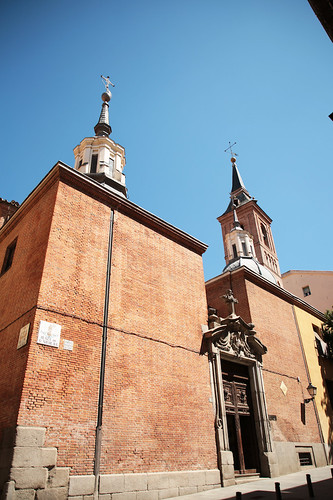 Also called the church of San Nicola de los Servitas, it is a Catholic parish church. From the medieval era (XIII century), this is the parish of the Italian community in Madrid: in a slightly secluded position, it is the oldest place of worship in the Spanish capital and seems to have been built where the second Mayrit mosque (first name of the city of Madrid) Muslim. In the Madrid Law of 1202, it is cited as one of the oldest parishes in the town. Today it is the oldest church in Madrid, after the demolition of the church of Santa Maria de la Almudena. The nave and chapels were renovated in the 17th century. The church is of modest size, so much so that initially I had not even seen it, its bell tower is the oldest preserved in Madrid, and the architect Juan de Herrera (1597, one of the foremost exponents of Renaissance art) is buried inside. Over the centuries the building has undergone many changes, modifications and renovations.
Also called the church of San Nicola de los Servitas, it is a Catholic parish church. From the medieval era (XIII century), this is the parish of the Italian community in Madrid: in a slightly secluded position, it is the oldest place of worship in the Spanish capital and seems to have been built where the second Mayrit mosque (first name of the city of Madrid) Muslim. In the Madrid Law of 1202, it is cited as one of the oldest parishes in the town. Today it is the oldest church in Madrid, after the demolition of the church of Santa Maria de la Almudena. The nave and chapels were renovated in the 17th century. The church is of modest size, so much so that initially I had not even seen it, its bell tower is the oldest preserved in Madrid, and the architect Juan de Herrera (1597, one of the foremost exponents of Renaissance art) is buried inside. Over the centuries the building has undergone many changes, modifications and renovations.
Plaza de la Villa
The Piazza Della Villa, located in the historic centre (not far from Puerta del Sol) is one of the best preserved monumental complexes in Madrid.
 This square was one of the leading and vital nuclei of the city in medieval times. From here, in fact, three roads begin that correspond to the primitive layout of the town: the Codo road, the Cordón road and the Madrid road. Along its sides, there are three significant buildings from an artistic point of view. On the eastern side, there is the Casa y Torre de los Lujanes (15th century), built in Gothic-Mudejar style (now home to the Academia de Ciencias Morales y Políticas). On the southern side is the Casa de Cisneros (XVI century), a Plateresque palace; finally, on the western side, we find the Casa de la Villa (XVII century), in baroque style, one of the seats of the Municipality of Madrid.
This square was one of the leading and vital nuclei of the city in medieval times. From here, in fact, three roads begin that correspond to the primitive layout of the town: the Codo road, the Cordón road and the Madrid road. Along its sides, there are three significant buildings from an artistic point of view. On the eastern side, there is the Casa y Torre de los Lujanes (15th century), built in Gothic-Mudejar style (now home to the Academia de Ciencias Morales y Políticas). On the southern side is the Casa de Cisneros (XVI century), a Plateresque palace; finally, on the western side, we find the Casa de la Villa (XVII century), in baroque style, one of the seats of the Municipality of Madrid.
 The current name of the square dates back to the 15th century when King Enrique IV de Castilla (1425-1474) attributed the title of Noble and Loyal Villa to Madrid. In 1888, on the occasion of the third anniversary of the death of the sailor Álvaro de Bazán (1526-1588), the Municipality decided to have a statue made in his memory: this was inaugurated in 1891 and, since then, it is located in the centre of the square.
The current name of the square dates back to the 15th century when King Enrique IV de Castilla (1425-1474) attributed the title of Noble and Loyal Villa to Madrid. In 1888, on the occasion of the third anniversary of the death of the sailor Álvaro de Bazán (1526-1588), the Municipality decided to have a statue made in his memory: this was inaugurated in 1891 and, since then, it is located in the centre of the square.
Statue of Julia
Walking along Calle del Pez, in the barrio of malasaña,
 you come across an urban statue that depicts a girl with books under her arm. Officially called “Tras Julia”, the figure (dated 2003) is the work of Antonio Santín. It is inspired by a true story of nineteenth-century Madrid, a time when women still could not enrol in university: Julia was an intelligent girl who wanted to study, wanted to learn and develop. So he decided to disguise himself as a man to attend classes at the Central University of Madrid. It is not known exactly who Julia was: some say that Julia was a representation of Concepción Arenal, jurist, writer and human rights activist, who in 1840 disguised herself to study law. Given the story he wants to tell, I went specifically to look for it, to see it live after seeing a picture of it (and having read something more on the internet). Since the statue of Julia was “people size”, coming from the noviciado metro station of (along Calle de San Bernardo) I had barely noticed it!
you come across an urban statue that depicts a girl with books under her arm. Officially called “Tras Julia”, the figure (dated 2003) is the work of Antonio Santín. It is inspired by a true story of nineteenth-century Madrid, a time when women still could not enrol in university: Julia was an intelligent girl who wanted to study, wanted to learn and develop. So he decided to disguise himself as a man to attend classes at the Central University of Madrid. It is not known exactly who Julia was: some say that Julia was a representation of Concepción Arenal, jurist, writer and human rights activist, who in 1840 disguised herself to study law. Given the story he wants to tell, I went specifically to look for it, to see it live after seeing a picture of it (and having read something more on the internet). Since the statue of Julia was “people size”, coming from the noviciado metro station of (along Calle de San Bernardo) I had barely noticed it!
Monument to Cervantes – Plaza de España
At the centre of the Plaza de España, overlooked by the Madrid Tower (1957) and the España Building, there is the fountain dedicated to Miguel de Cervantes.
 In 1915 was announced the competition for its construction, and the monument was primarily built between 1925 and 1930. The project is by architects Rafael Martínez Zapatero and Pedro Muguruza, and the sculptor Lorenzo Coullaut Valera and the memorial was completed between 1956 and 1957 by Federico Coullaut-Valera Mendigutia (or the son of the sculptor who had taken part in his conception). Only in 1960, however, were the statues of Dulcinea del Toboso, Rinconete and Cortadillo and Gitanilla (other characters born from the imagination of Cervantes) put in their current position. The monument, 35 meters high, is located in the middle of the garden of the square and is not very far from the royal palace and its gardens: it may, therefore, be a good idea to get there even after a visit to the royal palace itself.
In 1915 was announced the competition for its construction, and the monument was primarily built between 1925 and 1930. The project is by architects Rafael Martínez Zapatero and Pedro Muguruza, and the sculptor Lorenzo Coullaut Valera and the memorial was completed between 1956 and 1957 by Federico Coullaut-Valera Mendigutia (or the son of the sculptor who had taken part in his conception). Only in 1960, however, were the statues of Dulcinea del Toboso, Rinconete and Cortadillo and Gitanilla (other characters born from the imagination of Cervantes) put in their current position. The monument, 35 meters high, is located in the middle of the garden of the square and is not very far from the royal palace and its gardens: it may, therefore, be a good idea to get there even after a visit to the royal palace itself.
Templo de Debod
The temple of Debod is a temple of ancient Egypt located not far from the Plaza de España, next to the Paseo del Pintor Rosales (Parque del Oeste).
 Specifically, it is located on a hill where the Cuartel de la Montaña was established, the scene of a bloody episode of the Spanish Civil War. This temple was given, in 1968, from Egypt to Spain as a reward for the Spanish aid, in response to the international appeal of UNESCO to save the temples of Nubia, mainly that of Abu Simbel, in danger for the construction of the dam of Aswan. Once transported to Spain, it was rebuilt to respect approximately the original orientation, from east to west. The temples donated by Egypt are four, to four different countries: Dendur to the United States of America (it is currently at the Metropolitan Museum of Art in New York), Ellesija to Italy (preserved, it seems, at the Egyptian museum in Turin ), Taffa to the Netherlands and Debod to Spain.
Specifically, it is located on a hill where the Cuartel de la Montaña was established, the scene of a bloody episode of the Spanish Civil War. This temple was given, in 1968, from Egypt to Spain as a reward for the Spanish aid, in response to the international appeal of UNESCO to save the temples of Nubia, mainly that of Abu Simbel, in danger for the construction of the dam of Aswan. Once transported to Spain, it was rebuilt to respect approximately the original orientation, from east to west. The temples donated by Egypt are four, to four different countries: Dendur to the United States of America (it is currently at the Metropolitan Museum of Art in New York), Ellesija to Italy (preserved, it seems, at the Egyptian museum in Turin ), Taffa to the Netherlands and Debod to Spain.
 The temple dates back to the 2nd century BC when its oldest nucleus was built (under the reign of Pharaoh Ptolemy IV Philopator); it was decorated around 200 to 180 BC C., under the Nubian king Adijalamani of Meroe. Dedicated to Amon of Debod (“Amani”, in the Kushite language) and Isis. The temple was built in the small town of the same name in Lower Nubia, the “land of gold”, on the banks of the Nile, near the first cataract: a little further north was the magnificent sanctuary of the goddess Isis and this temple today in Spain was indirectly part of this sanctuary. It has significant additions from the Ptolemaic and Roman-imperial periods (from the 1st century BC to the 1st century AD). You can visit the building at the end of the temple, from Tuesday to Sunday with a broken schedule (10:00 – 14:00 and 18:00 – 20:00): the entrance is, looking at the temple from the front, on the left and I saw you very much. I suggest you go there in the late afternoon, towards sunset time, to find a beautiful light (when it gets dark, the temple is also illuminated).
The temple dates back to the 2nd century BC when its oldest nucleus was built (under the reign of Pharaoh Ptolemy IV Philopator); it was decorated around 200 to 180 BC C., under the Nubian king Adijalamani of Meroe. Dedicated to Amon of Debod (“Amani”, in the Kushite language) and Isis. The temple was built in the small town of the same name in Lower Nubia, the “land of gold”, on the banks of the Nile, near the first cataract: a little further north was the magnificent sanctuary of the goddess Isis and this temple today in Spain was indirectly part of this sanctuary. It has significant additions from the Ptolemaic and Roman-imperial periods (from the 1st century BC to the 1st century AD). You can visit the building at the end of the temple, from Tuesday to Sunday with a broken schedule (10:00 – 14:00 and 18:00 – 20:00): the entrance is, looking at the temple from the front, on the left and I saw you very much. I suggest you go there in the late afternoon, towards sunset time, to find a beautiful light (when it gets dark, the temple is also illuminated).
Puerta de Europa – Torres Kio
The two KIO towers represent a very important element of the Madrid skyline.
 115 meters high, with a square base of 35 meters per side, and inclined up to 14.3 degrees, the two towers are located in the centre of Plaza de Castilla, and the official name is “Gate of Europe”. The towers are arranged symmetrically concerning the axis of the Castellana, forming a sort of “gate” on the road below. The two buildings were built between 1990 and 1995 to a design by New York studio John Burgee Architects. Given the inclination, four of the eight elevators arrive only up to the thirteenth floor, and each level is different from the others (because the spaces are displaced concerning the central core of the elevators). They are two very particular buildings, which have impressed me a lot.
115 meters high, with a square base of 35 meters per side, and inclined up to 14.3 degrees, the two towers are located in the centre of Plaza de Castilla, and the official name is “Gate of Europe”. The towers are arranged symmetrically concerning the axis of the Castellana, forming a sort of “gate” on the road below. The two buildings were built between 1990 and 1995 to a design by New York studio John Burgee Architects. Given the inclination, four of the eight elevators arrive only up to the thirteenth floor, and each level is different from the others (because the spaces are displaced concerning the central core of the elevators). They are two very particular buildings, which have impressed me a lot.

